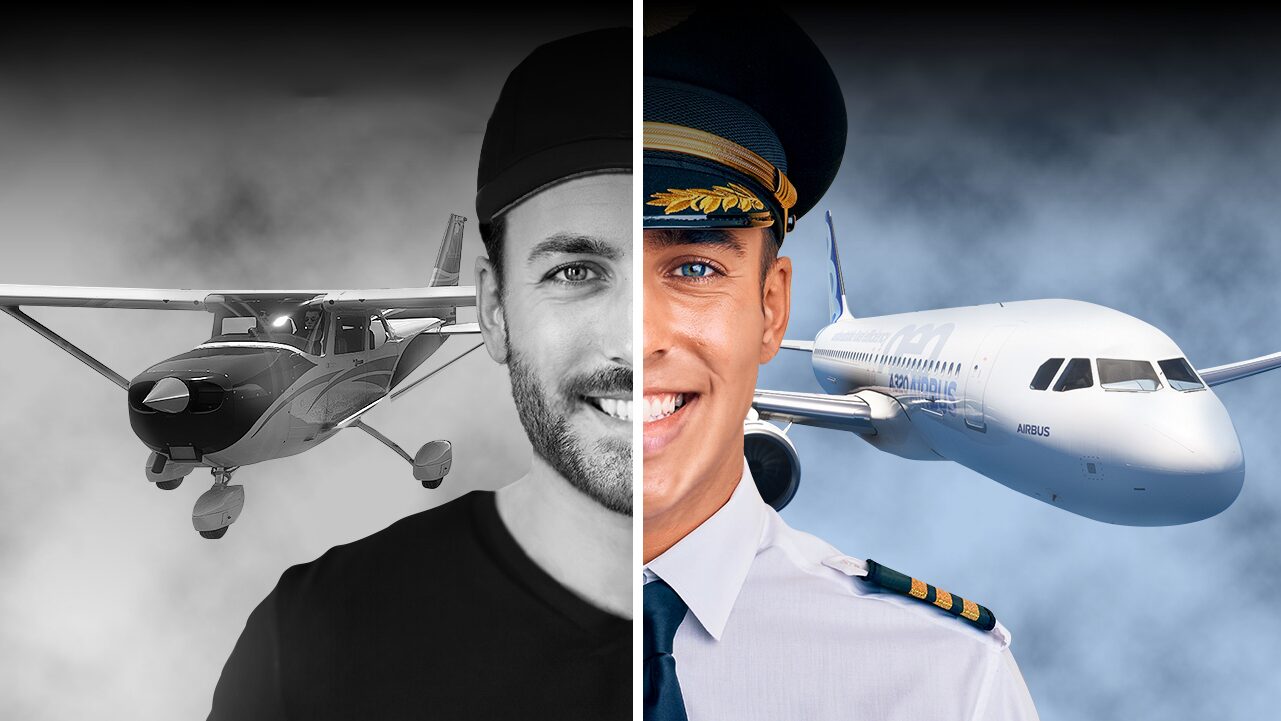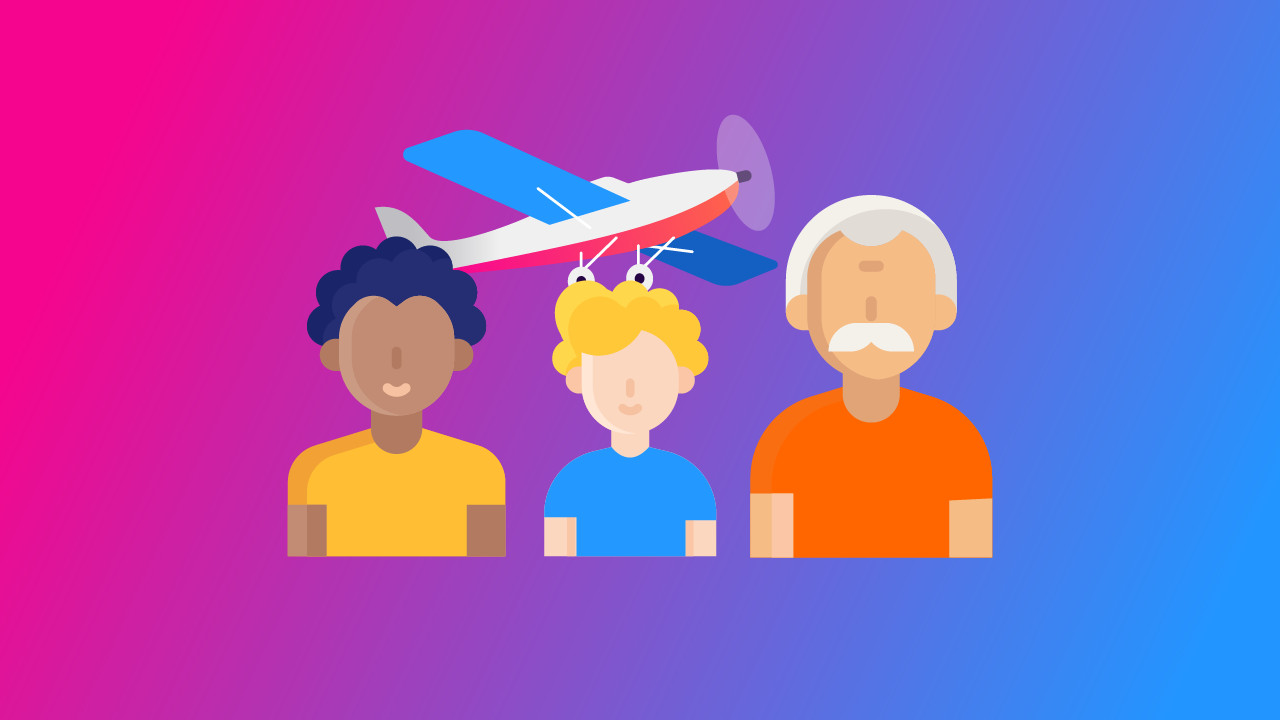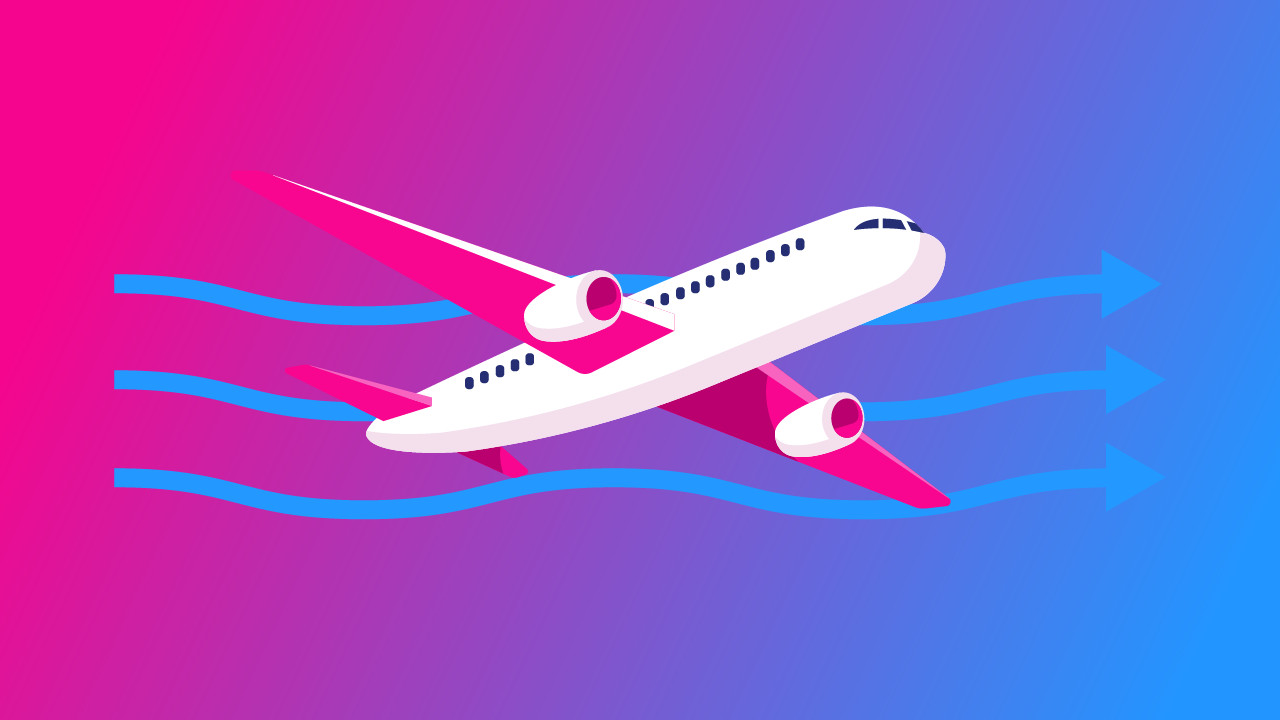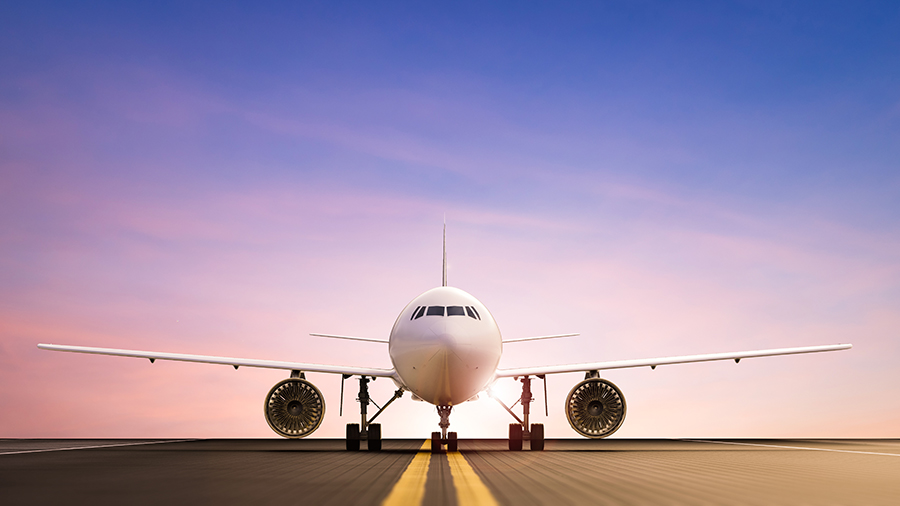-
Step 1: Assess Your Eligibility
- Age Requirements
- Citizenship and Language Requirements
- The FAA Medical
- Cost
-
Step 2: Choose a Pilot Certificate
- Student Pilot
- Private Pilot
- Recreational Pilot
- Sport Pilot
-
Step 3: Choose a Flight School
- Part 61 vs. Part 141
- Location
- Aircraft
- Airports
- Instructors
- Cost
-
Step 4: Begin Flight Training
- Training
- Knowledge Test
- Private Pilot Eligibility Requirements
- Practical Test
-
Step 5: Gain Flying Experience
- License to Learn
-
Step 6: Advance to Higher Licenses
- Instrument Rating
- Commercial Pilot
- Certified Flight Instructor
- Multi-Engine Rating
- Airline Transport Pilot
- Endorsements
-
Step 7: Build Your Career Path
-
Conclusion
Do you dream of flying but feel lost about how to start? We get it. There’s a lot to figure out.
The good news?
We’ll make it easy.
This article is your simple guide to becoming a pilot. We’ll explain everything you need to know to start flying and avoid common mistakes.
Whether you want to fly for fun or as a career, this guide is for you.

Step 1: Assess Your Eligibility
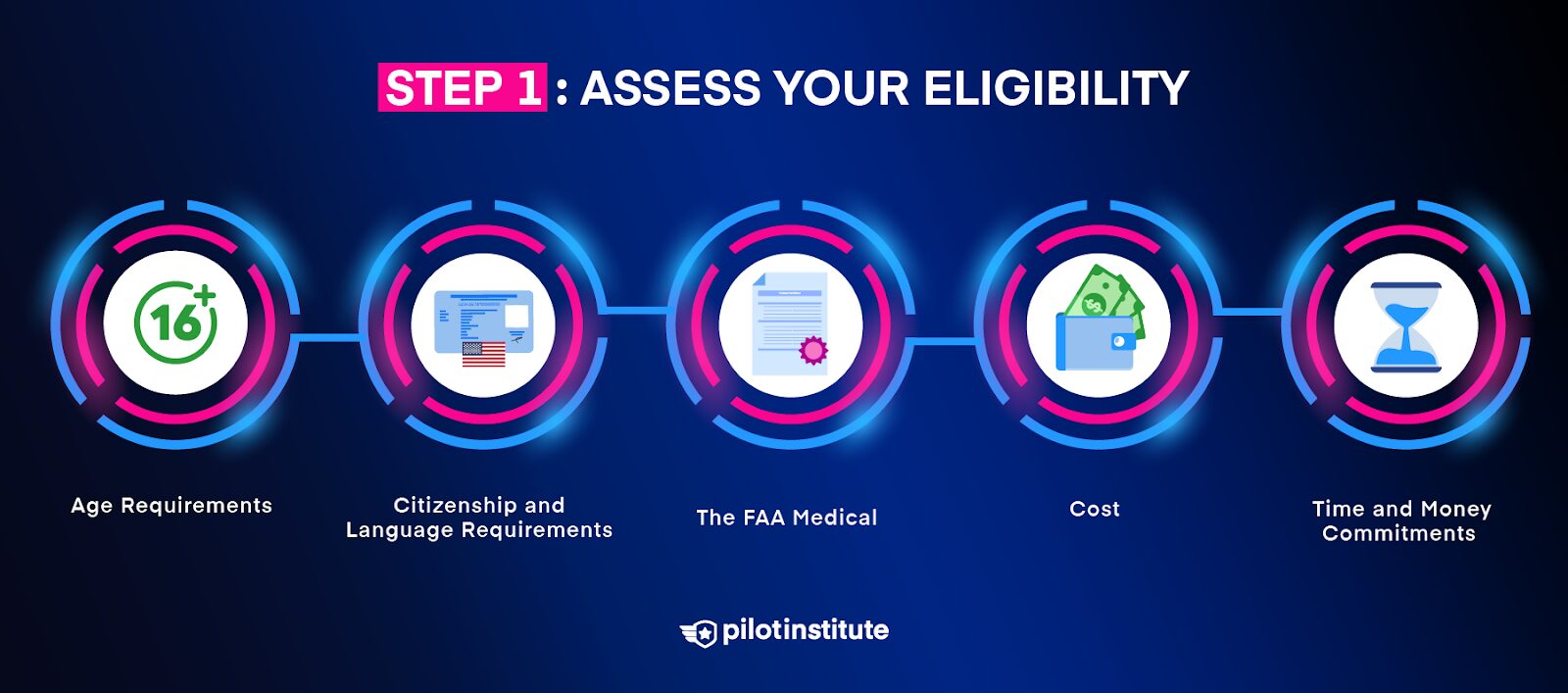
Now that you’ve decided to fulfill your aviation dream, it’s tempting to start calling flight schools and jumping right into flight training.
We can’t blame you there. Becoming a pilot is exciting!
But don’t start booking training sessions with an instructor just yet. There are a few requirements you’ll want to meet first. It’s better to address any eligibility issues before starting your flight lessons.
For this article, we’ll assume you want to fly airplanes, not aircraft such as gliders or balloons.
Age Requirements
You must be at least 16 years old to get your student pilot certificate. While you can be any (reasonable) age to begin flight training, you can’t fly solo until you have your student pilot certificate.
Keep in mind that you need to be 17 years old to become a private pilot.
Citizenship and Language Requirements
If you’re a U.S. citizen who can read, speak, write, and understand English, you can move on to the medical requirements section.
If you’re a non-U.S. citizen who wishes to train in the U.S., you must register with the Transportation Security Administration (TSA) before starting. If English is not your native language, you’ll need to demonstrate your English proficiency.
Read the article Getting Your Pilot’s License as a Non-US Citizen to learn more about the TSA’s requirements.
The FAA Medical
Ensuring you meet the FAA’s medical requirements before moving on with your flight training is crucial.
With a few exceptions, the Federal Aviation Administration (FAA) requires that any person acting as pilot-in-command (PIC) of an aircraft holds a medical certificate. A medical certificate is a document that proves you’re physically fit to fly an aircraft.
To qualify for a medical certificate, you must pass a physical exam performed by an Aviation Medical Examiner (AME).
Medical Classes
There are three classes of FAA medical certification. Choosing which class of medical to get depends on your aviation goals.
Third-Class Medical
A third-class medical has the least stringent medical standards. Among other privileges, a third-class medical allows you to act as PIC of an aircraft for non-commercial purposes. If you just want to fly for enjoyment, a third-class medical can get you from student to private (or recreational) pilot.
Second-Class Medical
A second-class medical allows you to exercise the privileges of a commercial pilot certificate. With at least a second-class medical, you can get paid to fly an aircraft.
First-Class Medical
If you’re considering a career in the airlines, you should ensure you qualify for a first-class medical. You need one to exercise the privileges of an Airline Transport Pilot (ATP) certificate.
Check out FAA Medical Certificate and Exam for Pilots Made Easy for an in-depth look at the FAA medical process.
The FAA Medical Exam
Most healthy people pass a medical exam without issue. According to the FAA, only about 1.5% of third-class medicals get denied. Ninety percent of denials happened because the pilot didn’t bring the necessary medical documentation.
In other words, preparation is the key to the medical exam!
Disqualifying Conditions
Only a few medical conditions will prevent you from flying any aircraft. If you have a medical condition that could be disqualifying, schedule a consultation with an AME. Only book the medical exam once you know you can pass.
Color Vision
Color vision deficiency (CVD) (commonly known as “colorblindness”) is quite common. In fact, it’s so common that it deserves its own section.
If you have CVD, you can only fly during daylight hours.
Many student pilots don’t know they are color vision deficient until the AME brings out the test plates.
If you want to make a career out of flying, you need to know whether you can pass one of the FAA’s approved color vision tests. If you’re concerned that your color vision is not good enough to pass, you should schedule a consultation with an AME or ophthalmologist. Do this before you book your medical exam.
BasicMed
Since 2007, the FAA has allowed pilots to fly small general aviation aircraft without taking an FAA medical with an AME. This new set of regulations, called BasicMed, makes it easier for many pilots to keep flying.
BasicMed requires that you hold a pilot certificate and have held a valid FAA medical certificate after July 14, 2006. So, if you don’t yet have a medical and aren’t a certificated pilot, you can’t fly under BasicMed.
To read more about BasicMed, check out our BasicMed Guide.
Cost
Before we move on, let’s talk about the cost of flight training.
Flight training isn’t cheap. A private pilot certificate’s minimum flight time requirement is 40 hours, but the average training time is 60 to 75 hours.
The training cost of becoming a private pilot is around $15,000 to $20,000. Sport pilot training is cheaper at about $8,000. If you want to go up to the ATP level, you might be looking at $50,000 to $100,000 or more, depending on where and how you train.
Time and Money Commitments
Make sure you’ve set aside the appropriate funds for your flight training. Running out of money mid-training will cost you more in the long run. You’ll need extra flight time to reach the level of proficiency you had before you stopped.
Commit to flying two to three days per week. Flight skills deteriorate without continuous practice, particularly early on in training. Setting aside adequate training time is as important as setting aside sufficient funds.
Don’t forget that flight training isn’t only flying. Studying the rules and regulations requires significant time and dedication.
Training without gaps is the best way to ensure your aviation journey is smooth, efficient, and enjoyable.
Step 2: Choose a Pilot Certificate

There are many different ways to fly and enjoy the thrill of aviation.
Perhaps you just want to putter along low and slow on nice sunny days. Maybe you plan on cruising cross-country with friends and family. Or, possibly, you’ve set your sights on the cockpit of an airliner.
If you plan to make a career out of flying or simply want the most flying privileges you can get, you’ll need to pursue a private pilot certificate. A sport pilot or recreational pilot certificate might be enough if you only want to fly for fun.
Let’s go over the different types of initial pilot certificates and what they offer.
Student Pilot
If you plan on earning your private pilot or recreational pilot certificate, you must get your student pilot certificate first.
You don’t need a student pilot certificate to fly with an instructor, but you do need it to fly solo (with permission from an instructor). It can take around three weeks to receive your certificate from the FAA, so apply for one before you start training.
Check out our article on How to Get a Student Pilot License for a step-by-step guide on the application process.
Private Pilot
The private pilot certificate is the most commonly issued pilot certificate.
As a private pilot, you can carry passengers, fly long distances, and land at any civilian airport in the country. Piloting more powerful, higher-flying, and complex aircraft is possible with further training and qualifications.
If you plan on making flying a career, getting your private pilot certificate is necessary. It’s a prerequisite for earning your commercial pilot certificate.
Recreational Pilot
A recreational pilot certificate is like a limited private pilot certificate. It isn’t that popular because it’s not much easier to get than a private pilot certificate and has several restrictions.
Without further endorsements, a recreational pilot cannot fly at night, fly further than 50 nautical miles from their departure airport, or fly to an airport with a control tower. They are also restricted to aircraft with four seats or fewer and can only carry one passenger.
Sport Pilot
In 2004, the FAA created the sport pilot certificate. This certificate allows pilots to fly light-sport aircraft (LSA) without needing a medical or even a student pilot certificate.
Light-sport aircraft are, unsurprisingly, very light and can carry up to one passenger. A sport pilot can only fly LSA during the day in good weather. But if that’s all you need to scratch the aviation itch, a sport pilot certificate might be right for you.
Step 3: Choose a Flight School
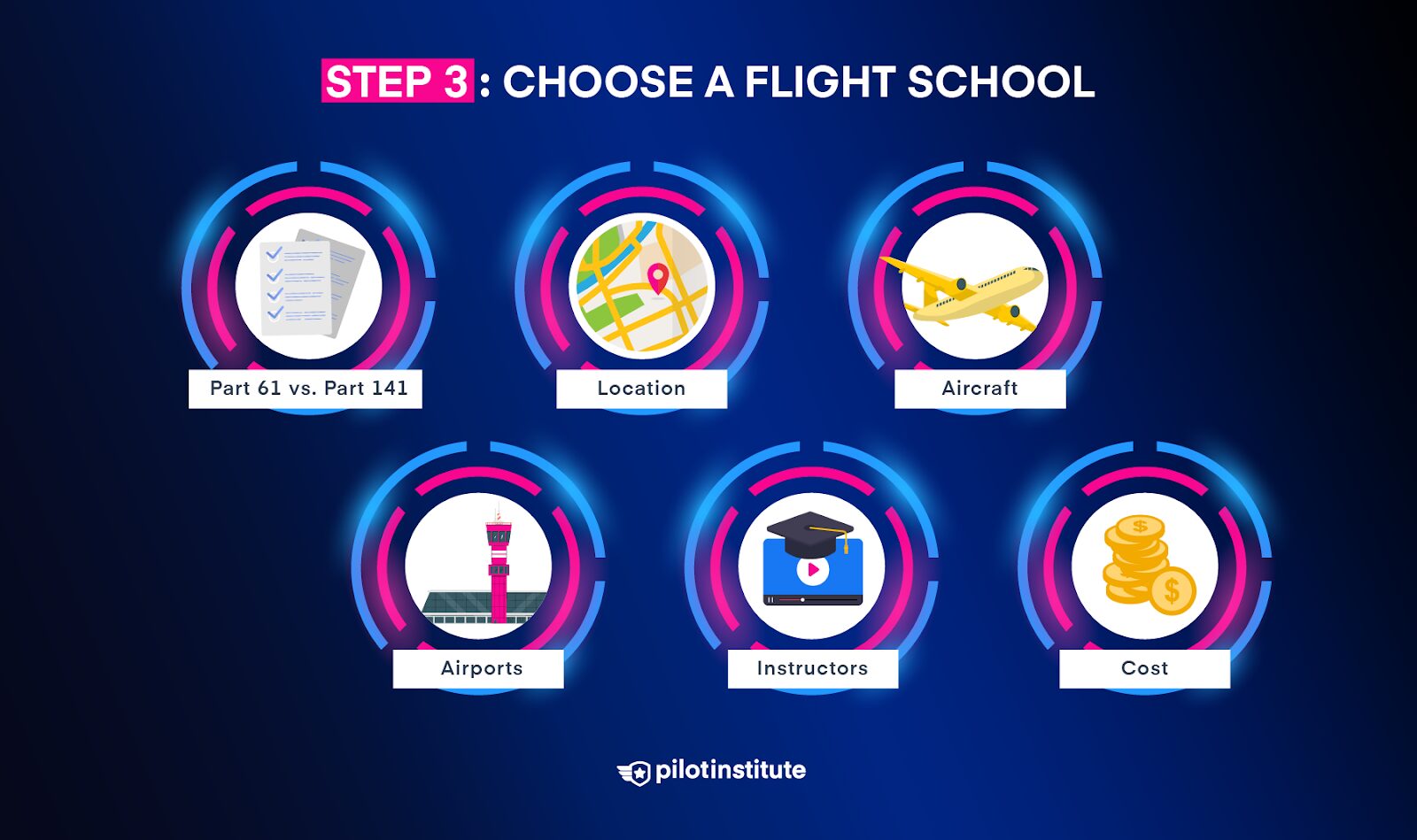
You have your medical in hand. You’ve chosen the pilot certificate you want to pursue. You’ve set aside the necessary funds and committed to flying at least two or three days a week.
The next step is choosing a flight school.
At first glance, it doesn’t seem too difficult of a choice. Just choose the nearest and cheapest flight school, right?
Well, not necessarily.
Let’s discuss some factors you should consider when deciding where to train.
Part 61 vs. Part 141
You might have seen the terms “Part 61” and “Part 141” on training websites. They are shorthand for Part 61 and Part 141 of the Federal Aviation Regulations.
Let’s clarify.
A flight school can operate under either Part 61 or Part 141 regulations. The regulations specify how the school has to conduct its training.
Part 61 schools offer a more flexible and customizable training program. Part 141 schools have a more rigid and structured training curriculum. Neither one is “better,” only different.
A Part 61 school requires at least 40 hours of flight time to take your private pilot test, whereas a Part 141 school only requires 35. This difference isn’t significant since most pilots need more than 40 hours to prepare for their test.
A more important difference is that you can get your commercial pilot certificate with 190 flight hours at a Part 141 school. A Part 61 school requires 250 hours. So, if you plan to be a professional pilot, a Part 141 school might get you there faster.
We suggest you look more closely at the differences between Part 61 and Part 141 schools in this article: Part 61 vs. Part 141: What’s the Difference?
Location
Distance
The closer you are to your flight school, the more you’ll fly.
If it takes ages to get to the airport, you’re using up time better spent on flying or studying.
Weather
Not all locations are conducive to year-round flying. Even the Wright Brothers moved their flight training operation from Ohio to Alabama to avoid winter weather.
Flight schools based in sunnier, milder parts of the country can offer accelerated flight training programs. If you want to train quickly, consider temporarily relocating for training if you have that level of freedom.
Aircraft
Flight school aircraft can vary in type, condition, and equipment.
Many pilots suggest training in older analog “steam gauge” aircraft, particularly for student pilots. You can also find pilots who recommend training in modern “glass cockpit” aircraft.
There is no right or wrong answer here, and there are benefits to training in either – or both – types.
Most importantly, though, is that the aircraft are in good condition and well maintained.
Airports
There are flight schools at almost every airport.
You can find them in rural airports, and you can find them in large airports with busy commercial traffic.
As with aircraft, airport choice comes down to your goals and preferences.
Small, non-towered airports are often quicker to get in and out of. The flight schools at these airports can be cheaper. The relative simplicity of operations can be less distracting when you first start training.
Bigger, towered airports can be more difficult (and expensive) to fly in and out of. On the plus side, you get used to talking with Air Traffic Control (ATC) every time you fly. Working with ATC is something you’ll do on every flight as a professional pilot.
Instructors
The factors we just discussed are all important. But no matter where or how you train, it’s up to your CFI to ensure you’re learning well and enjoying flight training.
Whether or not you and your instructor are a good match often comes down to communication style and personality. That’s hard to predict.
See if you can book a short introductory “discovery flight” with a prospective CFI to get a sense of their instructional style. If you feel the instructor is not a good match for you, don’t hesitate to seek another CFI. “Trust your gut,” as they say.
Cost
When you start to narrow down your list of flight schools, it’s a good idea to do a bit of number crunching.
Although cost isn’t necessarily the most important factor when choosing a flight school, it’s certainly not unimportant. But don’t choose the cheapest option if it doesn’t meet your training goals.
Perhaps you’d rather pay extra to fly more modern aircraft. Maybe you think the additional cost of flying at a towered airport is worth the ATC experience you get. The quality of training that a more experienced CFI can offer might offset the higher price.
Only you can decide what’s right for you.
Step 4: Begin Flight Training
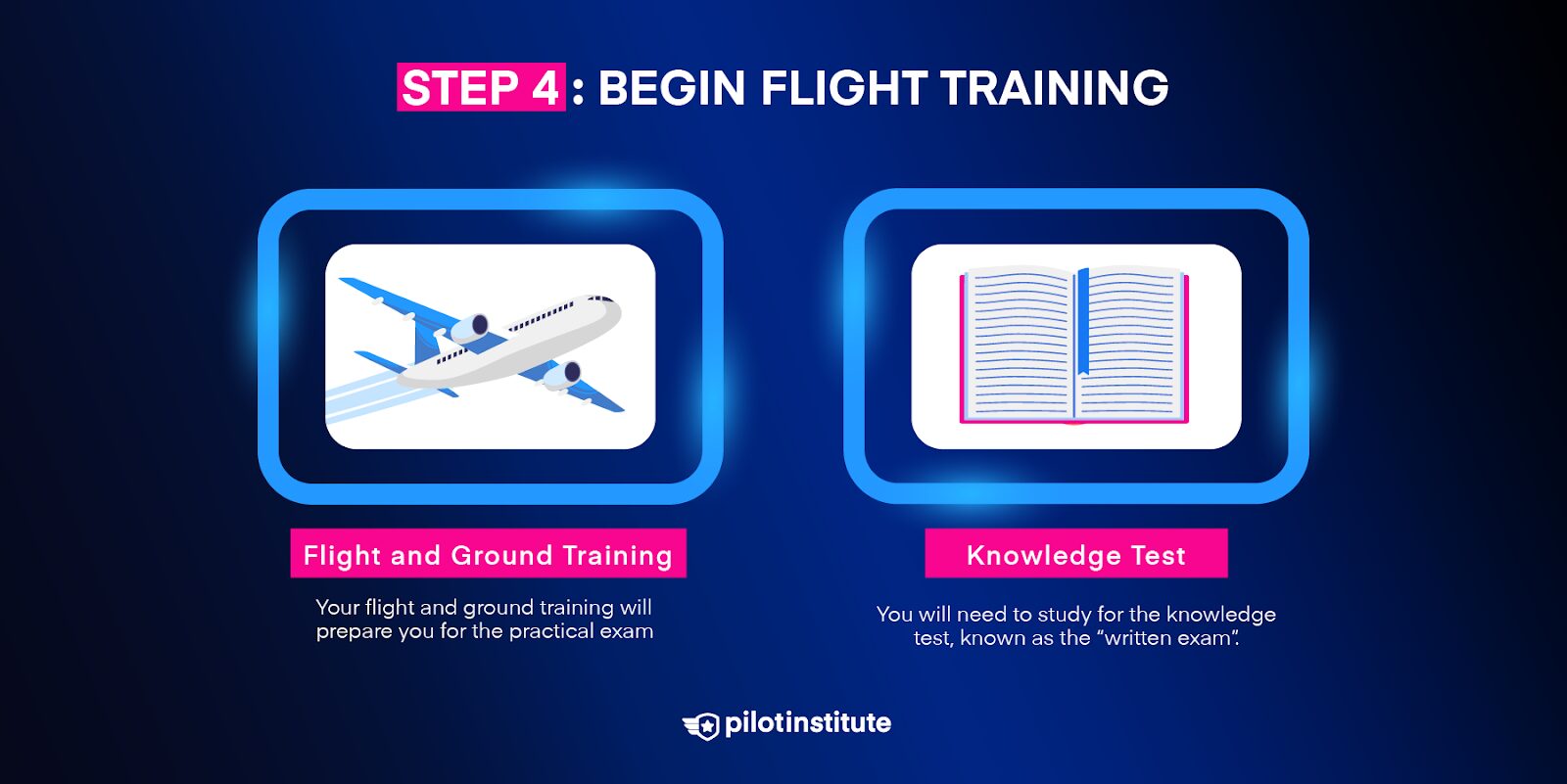
There’s nothing like walking into a flight school as a student for the first time.
It can be very overwhelming at first.
The hustle and bustle of pilots pre-flighting and debriefing makes your head spin. The distant sound of aircraft starting and taking off gives you butterflies.
Don’t worry! Every pilot that came before you felt the same way. You’ll soon feel much more confident and less overwhelmed.
Training
Once you meet with your instructor, you’ll review some paperwork. Your CFI will cover how training will progress, including how to use the course syllabus.
If the weather is good, your instructor won’t spend too much time inside with you. After going over the outline of your first lesson, you’ll both head out to the aircraft, headsets in hand.
Flight Training
During your first lesson, your instructor will demonstrate how to operate the aircraft from preflight inspection to engine shutdown. You’ll take off, perform some simple maneuvers, and come back for landing about 30 to 45 minutes after departure.
A postflight briefing will follow each lesson, where you and your instructor will discuss the flight. They’ll cover what you did well and what needs improvement. Don’t let critiques discourage you. No pilot is perfect!
Your instructor will want you to fly the aircraft as much as possible, even during the first flight. With each new lesson, you’ll do more of the flying. Soon, your instructor will be as hands-off as possible while you navigate the skies with ease.
Ground Training
Training doesn’t only happen in the aircraft. A good chunk of it happens on the ground between flying lessons.
Safely operating an aircraft requires a lot of knowledge. Acquiring that knowledge takes time and effort.
If you enrolled in a Part 141 course, you need to attend “ground school.” If you’re training under Part 61, your flight school may or may not offer a ground instruction course. If not, you can sign up for one elsewhere or take a home-study course like our Private Pilot Made Easy class.
First Solo
When your instructor is confident in your flying abilities, aviation knowledge, and decision-making skills, they’ll endorse you for your first solo.
Flying solo is when you truly become a pilot. It’s just you, the aircraft, and the sky as you fly around the traffic pattern with your instructor watching proudly from the ground.
Your first solo is a momentous occasion and one you’ll never forget. Make sure to celebrate!
Knowledge Test
After your first solo, it’s time to start thinking about taking your FAA Private Pilot Knowledge Test, commonly called the “written test.”
You could take the knowledge test before you even start training. However, most people find it easier to study for it after gaining some real-world experience under their belt.
The test consists of 60 multiple-choice questions that you have two hours to complete. The minimum passing score is 70%. Ninety percent of test-takers pass the exam with an average score of 83%, so don’t worry too much.
You’ll need an instructor endorsement or a graduation certificate from a ground school or self-study program to take the test.
Check out our Checklist to Ace Your FAA Private Pilot Written Test to learn more about the knowledge test.
Private Pilot Eligibility Requirements

You and your flight instructor must ensure you meet specific requirements for private pilot certification.
Let’s take a general look at the requirements for Part 61 certification.
General Requirements
The general requirements include meeting the age requirements, passing the knowledge test, possessing a student pilot certificate, and having the proper logbook endorsements from your instructor.
Read the complete list of requirements in FAR 61.103.
Aeronautical Knowledge
The aeronautical knowledge requirements include the knowledge areas you studied during ground school. Using charts, communicating with ATC, understanding weather, and aeronautical decision-making are examples of required knowledge.
Read the complete list of knowledge areas in FAR 61.105.
Flight Proficiency
The flight proficiency requirements outline the flight skills you need to demonstrate to become a private pilot. They include takeoffs, landings, maneuvers, navigation, emergency procedures, and, well, everything you learned during flight training.
Read the complete flight proficiency requirements in FAR 61.107.
Aeronautical Experience
The experience requirements list the required flight hours for different types of flying. Your first solo cross-country flight will be a big thrill and something to be immensely proud of.
You need at least:
- 40 total hours of flight time.
- 20 hours of flight training.
- 10 hours of solo flight, including:
- 5 hours of cross-country time.
- One cross-country of at least 150 nautical miles total (one leg of at least 50 nautical miles) with landings at three points.
- 3 takeoffs and landings to a full stop at a towered airport.
- 3 hours of cross-country flight training.
- 3 hours of night flight training, including:
- One cross-country flight of at least 1000 nautical miles.
- 10 takeoffs and 10 landings to a full stop.
- 3 hours of flight training solely by reference to instruments.
- 3 hours of training in preparation for the practical test within the preceding two months of the test.
Students rarely obtain their private certificate with 40 hours of total time. Expect to fly around 60 to 90 hours.
Read the complete list of aeronautical experience requirements in FAR 91.109.
Practical Test
At this point, the only thing between you and your private pilot certificate is the practical test, commonly known as the “checkride.”
Once you meet the requirements for private pilot certification, your instructor will sign your logbook. Their endorsement certifies that you’re ready for the practical test.
An FAA Designated Pilot Examiner (DPE) will administer the test. Their job is to ensure you are a qualified, proficient, and safe pilot. They’re not “out to get you.”
The ACS
The framework of the practical test is the Private Pilot–Airplane Airman Certification Standards (ACS).
The ACS outlines every knowledge area you must know and skill you’ll need to demonstrate. You won’t have time to address every item in the ACS (thankfully), but your examiner must test certain areas.
The practical test includes an “oral” portion and a flight portion. The oral exam is about an hour and a half long, and the flight portion is about an hour long.
“Oral” Exam
The oral exam happens on the ground. It’s essentially a conversation between you and the DPE. They will evaluate your aviation knowledge and decision-making skills. Your examiner could ask you to discuss any Knowledge area listed in the ACS.
Flight Portion
When your DPE is confident in your aviation knowledge, it’s time to hop in the aircraft.
Once again, the ACS is your guide. Your DPE can ask you to perform any item in the “Skills” sections. Since you’re fully prepared, there won’t be any surprises.
To learn more about preparing for your practical test, check our article on How to Pass Your Private Pilot Checkride.
Passing the Test
Once you’ve satisfied the DPE with your knowledge and flying skills, you’ll officially be a private pilot. Congratulations!
Now is a great time to share the joy of flight with friends and family.
Step 5: Gain Flying Experience
License to Learn
Wise pilots will tell you that a private pilot certificate is a “license to learn.” What does that mean?
As a certificated pilot, you’ve proven you have the required aviation skills and knowledge. But an intelligent pilot knows they can’t know everything. This is particularly true for new pilots. Earning your pilot certificate is only the first step in becoming the best pilot you can be.
Gaining more flight experience is an essential part of not just maintaining but improving your piloting skills.
Additionally, if you want to become a professional pilot, you’ll need more flight hours to qualify for the commercial pilot certificate.
Here’s a list of great ways to gain flying experience with your private pilot certificate:
- Take cross-country trips.
- Fly with friends.
- Learn to fly new aircraft.
- Join a flying club.
- Fly as a safety pilot.
- Volunteer for organizations like Pilots N Paws.
Step 6: Advance to Higher Licenses
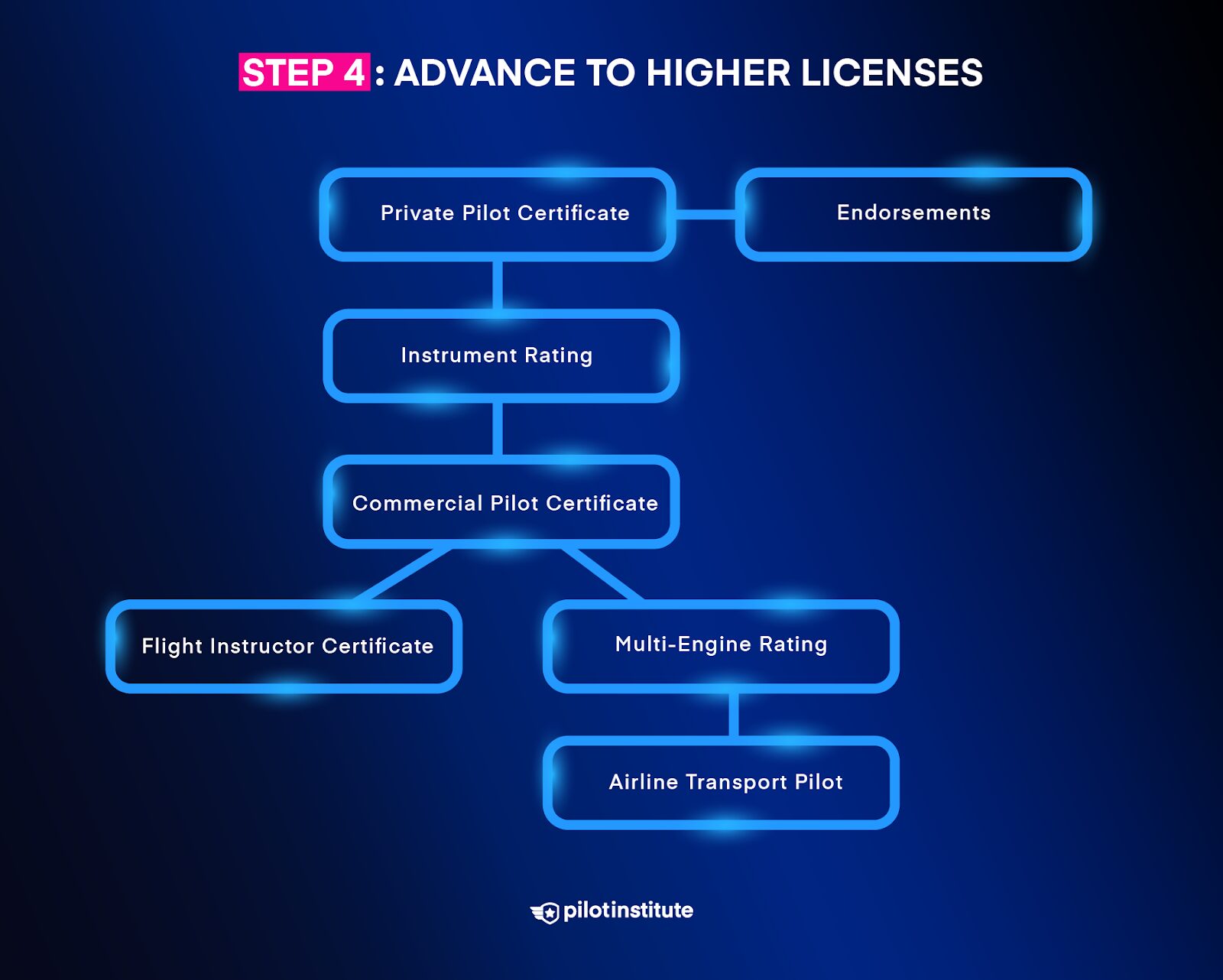
If your goal is to become a career pilot, you need to earn higher-level pilot certificates. Even if you only fly for enjoyment, continuing flight training is an excellent way to improve your piloting skills.
For each rating and certificate listed in this section, you must meet eligibility and experience requirements, pass a knowledge test, and take a practical test.
Instrument Rating
Many pilots start working on their instrument rating shortly after earning their private pilot certificate.
The instrument rating allows you to fly solely by reference to your flight instruments under instrument flight rules (IFR). A pilot must have an instrument rating to operate an aircraft in clouds or low visibility. Without an instrument rating, a private pilot can only fly in good weather and cannot fly in clouds.
The instrument rating makes you a safer pilot and dramatically expands the range of weather conditions in which you can fly. It’s hard to beat the thrill of popping out of a cloud layer 200 feet above the ground to see the runway in front of you.
Learn more about earning your instrument rating here: How to Get an Instrument Rating – Step-by-Step.
Commercial Pilot
If you’re planning a career as a pilot, you will need to earn at least a commercial pilot certificate. To be eligible, you must hold a private pilot certificate.
A commercial certificate allows you to earn money by flying aircraft. As you might expect, the commercial certificate requires you to fly to a high level of precision and safety.
You don’t technically need an instrument rating to earn your commercial certificate. However, job opportunities for a non-instrument-rated pilot are slim. Since you need 250 hours of total flight time for the commercial certificate (190 hours for Part 141), getting the instrument rating first is a good idea.
If you train smartly, you can complete some commercial certificate requirements while working on your instrument rating.
Learn more about earning your commercial certificate here: How to Get a Commercial Pilot License – Step-by-Step.
Certified Flight Instructor
Earning a flight instructor certificate is a common next step for aspiring professional pilots.
Becoming a CFI is a fantastic way to give back to the aviation community and share your love of flying with others. For commercial pilots, flight instructing is often their first paid flying job. That’s an achievement to be proud of!
The money it takes to train up to the commercial and CFI level is not trivial. However, many pilot careers require more flight hours than a brand-new commercial pilot or CFI has. As a CFI, you can gain flight hours and experience without paying for it yourself.
Learn more about getting your flight instructor certificate here: How to Become a Flight Instructor.
Multi-Engine Rating
At this stage in your training, you’re only certified to pilot single-engine aircraft. However, many pilot jobs require flying aircraft with more than one engine.
To qualify to fly multi-engine aircraft, you need a multi-engine rating. Multi-engine aircraft are more complex and faster than most single-engine general aviation aircraft.
The increased difficulty of flying multi-engine aircraft requires additional instruction. There is no minimum training hours requirement for the multi-engine rating. However, expect about 10 to 15 hours of instruction to become proficient.
Once your instructor is happy with your multi-engine skills, they’ll endorse you for the (commercial or private pilot) practical test. You won’t have to repeat the entire test, just certain parts of it. You won’t need to take another knowledge test.
Passing the test will add the multi-engine rating to your existing certificate.
Airline Transport Pilot
The airline transport pilot (ATP) certificate is the ultimate pilot achievement. It is the culmination of all you’ve learned during your aviation journey.
An ATP certificate is a requirement for becoming an airline pilot. You can find the complete list of ATP requirements under FAR 61.159.
The main hurdle to earning your ATP certificate is getting 1,500 hours of total flight time. As mentioned, many aspiring airline pilots gain those 1,500 hours by instructing. Some pilots find other commercial flying jobs that don’t require an ATP, like flying cargo under FAR Part 91. Many do a bit of both.
Once you’ve earned that coveted ATP certificate, you’re on your way to getting the airline job of your dreams.
Learn more about getting your airline transport pilot certificate here: How to Get an Airline Transport Pilot Licence (Step-By-Step).
Endorsements
Additional certificates and ratings aren’t the only ways to improve your airmanship.
Endorsements are another great way to expand your aviation skillset. Endorsements are privileges given to you by an instructor without requiring an FAA practical or knowledge test.
Getting them can be a lot of fun, too.
Here are some of the airplane endorsements you can receive:
- Tailwheel Airplane Endorsement.
- Allows you to fly a tailwheel aircraft.
- Requires flight training.
- Complex Airplane Endorsement.
- Allows you to fly an airplane with a controllable-pitch propeller, retractable landing gear, and flaps.
- Requires ground and flight training.
- High-Performance Endorsement.
- Allows you to fly an airplane with an engine of more than 200 horsepower.
- Requires ground and flight training.
- High-Altitude Endorsement.
- Allows you to fly an aircraft with a service ceiling or maximum operating altitude (whichever is lower) of 25,000 feet MSL.
- Requires ground and flight training.
Step 7: Build Your Career Path
Many aspiring professional pilots set their sights on flying for the airlines. But remember that plenty of other fulfilling and well-paying pilot careers exist.
Here’s a short list of non-airline pilot careers:
- Cargo operations.
- Private charters.
- Ferry operations.
- Corporate and business aviation.
- Air taxi.
- CFI.
- Air ambulance.
- Government or law enforcement.
- Patrol pilot.
- Aerial photography.
- Agricultural and crop-dusting.
- Firefighting operations
- Air tour pilot.
Conclusion
The path to becoming a pilot is a challenging one. However, pilots who plan ahead will find the flight training process more rewarding and enjoyable.
We hope this guide can give you an overview of the flight training process, whether you want to fly for the airlines, for your personal enjoyment, or somewhere in between.
Every pilot’s path is different. But no matter where we end up, we all started in the same place. Day one, lesson one.
Enjoy the journey.
While you’re researching flight schools and scheduling your medical exam, why not get a jump start on your aviation knowledge? Check out the Top 5 Books for Pilots During Training. Three of the five books listed are free and available online, so what are you waiting for? Start studying today!
